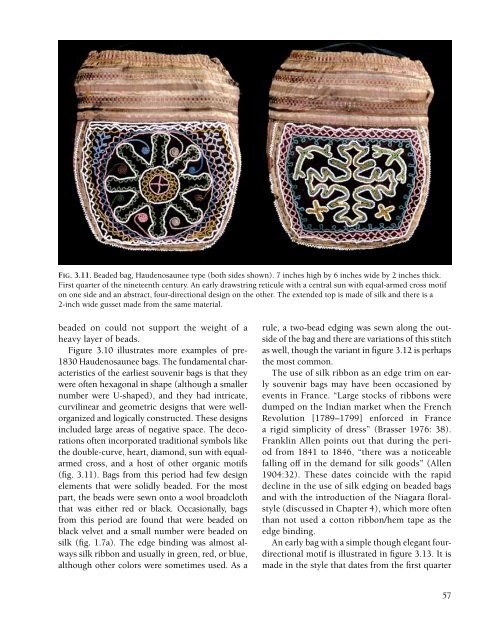A CHERISHED CURIOSITY - GERRY BIRON
A CHERISHED CURIOSITY - GERRY BIRON
A CHERISHED CURIOSITY - GERRY BIRON
You also want an ePaper? Increase the reach of your titles
YUMPU automatically turns print PDFs into web optimized ePapers that Google loves.
fig. 3.11. Beaded bag, Haudenosaunee type (both sides shown). 7 inches high by 6 inches wide by 2 inches thick.<br />
First quarter of the nineteenth century. An early drawstring reticule with a central sun with equal-armed cross motif<br />
on one side and an abstract, four-directional design on the other. The extended top is made of silk and there is a<br />
2-inch wide gusset made from the same material.<br />
beaded on could not support the weight of a<br />
heavy layer of beads.<br />
Figure 3.10 illustrates more examples of pre-<br />
1830 Haudenosaunee bags. The fundamental characteristics<br />
of the earliest souvenir bags is that they<br />
were often hexagonal in shape (although a smaller<br />
number were U-shaped), and they had intricate,<br />
curvilinear and geometric designs that were wellorganized<br />
and logically constructed. These designs<br />
included large areas of negative space. The decorations<br />
often incorporated traditional symbols like<br />
the double-curve, heart, diamond, sun with equalarmed<br />
cross, and a host of other organic motifs<br />
(fig. 3.11). Bags from this period had few design<br />
elements that were solidly beaded. For the most<br />
part, the beads were sewn onto a wool broadcloth<br />
that was either red or black. Occasionally, bags<br />
from this period are found that were beaded on<br />
black velvet and a small number were beaded on<br />
silk (fig. 1.7a). The edge binding was almost always<br />
silk ribbon and usually in green, red, or blue,<br />
although other colors were sometimes used. As a<br />
rule, a two-bead edging was sewn along the outside<br />
of the bag and there are variations of this stitch<br />
as well, though the variant in figure 3.12 is perhaps<br />
the most common.<br />
The use of silk ribbon as an edge trim on early<br />
souvenir bags may have been occasioned by<br />
events in France. “Large stocks of ribbons were<br />
dumped on the Indian market when the French<br />
Revolution [1789–1799] enforced in France<br />
a rigid simplicity of dress” (Brasser 1976: 38).<br />
Franklin Allen points out that during the period<br />
from 1841 to 1846, “there was a noticeable<br />
falling off in the demand for silk goods” (Allen<br />
1904:32). These dates coincide with the rapid<br />
decline in the use of silk edging on beaded bags<br />
and with the introduction of the Niagara floralstyle<br />
(discussed in Chapter 4), which more often<br />
than not used a cotton ribbon/hem tape as the<br />
edge binding.<br />
An early bag with a simple though elegant fourdirectional<br />
motif is illustrated in figure 3.13. It is<br />
made in the style that dates from the first quarter<br />
57


